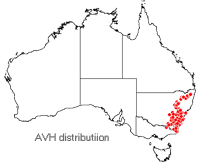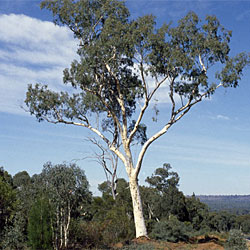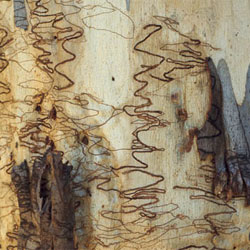Eucalyptus rossii
Inland Scribbly Gum
Eucalyptus rossii R.T.Baker & H.G.Sm.
 Eucalyptus rossii is a member of the Myrtaceae family. Known as the Inland Scribbly Gum or White Gum, it is an attractive small to medium-sized tree and commonly grows to a height of 15 m. It usually has a solitary trunk that is straight. Eucalyptus rossii is distributed across the New South Wales Tablelands and Western Slopes as well as the Central Coast.
Eucalyptus rossii is a member of the Myrtaceae family. Known as the Inland Scribbly Gum or White Gum, it is an attractive small to medium-sized tree and commonly grows to a height of 15 m. It usually has a solitary trunk that is straight. Eucalyptus rossii is distributed across the New South Wales Tablelands and Western Slopes as well as the Central Coast.
It has a smooth yellowish bark throughout that sheds each year in patches, creating a mottled greyish-white appearance. Older trees tend to shed limbs creating nesting hollows for birds. Its most striking feature is the insect scribbles that are commonly found on the bark. These are created by the burrowing larvae of a small moth Ogmograptis scribula. The moth lays eggs between layers of bark and when the larvae hatch they burrow in the bark. As last season’s bark is shed, a new pattern of distinctive scribbles are revealed, changing the character of the tree from year to year.
There are several other trees that are also found with scribbles, including Eucalyptus haemastoma and Eucalyptus racemosa. E. haemastoma has a small twisted trunk and is mostly found in Sydney. E. racemosa is similar to Eucalyptus rossii however it is distributed along the east coast from Nowra to Bundaberg.
Adult leaves are green to greyish-green and up to 150 mm long. Eucalyptus rossii flowers from December to February and has white flowers in clusters of 5-12. Honey eaters are attracted to the flowers. The flowers form capsules or gum nuts that are hemispherical and less than one centimetre in diameter.
It grows in areas of moderate temperature and rainfall of 600-1000mm per year. It prefers well drained soils, which is why it is usually found growing on slopes. It will tolerate frost and is a good landscape tree that will grow well in stands.
Propagation of Eucalyptus rossii is by seed and there is no dormancy period. The seed will take five to twenty eight days to germinate at 25 degrees Celsius.
Eucalyptus rossii is widely cultivated, particularly in the ACT. It would make a good feature tree on a larger block, providing good shade. However, the timber is light and brittle. All eucalypts have an efficient method for shedding limbs, as described by Jacobs (1955). For this reason, larger species such as E. rossii should not be planted so that they will overhang dwellings. Eucalyptus rossii is a very hardy and durable tree that is indigenous to the Canberra region and once established requires little maintenance.
Text by Patrick Mickan (2011 Student Botanical Intern)
Name Meaning: Eucalyptus rossiiEucalyptus – from the Greek words eu meaning ‘well’ and calyptos meaning ‘veiled or covered’. rossii – honours science teacher William John Clunies Ross (1850- 1914) who provided specimens for Baker and Smith who described the species. |
References
Australian National Botanical Gardens (2007) Scribbly Gum Moth. Available at http://www.anbg.gov.au/anbg/insects/ogmograptis.html [Viewed May 2011].
Brooker, M.I.H. & Kleinig, D.A. (1999) Field guide to Eucalypts Volume 1: south-eastern Australia, 2nd edition, Bloomings Books, Hawthorn Vic.
Diversity Native Seeds (2008) Eucalyptus rossii. Inland scribbly gum. Available at http://diversitynativeseeds.com.au/main/page_information_species_profiles_eucalyptus_rossii.html [viewed May 2011].
Holliday, I. & Watton, G. (2002) Gardener’s Companion to Eucalypts, 4th edition, Reed New Holland
Hill, K. (2011) Eucalyptus rossii R.T.Baker & H.G.Sm., in PlantNET - The Plant Information Network System of The Royal Botanic Gardens and Domain Trust, Sydney, Australia (version 2.0). Available at http://plantnet.rbgsyd.nsw.gov.au.
Jacobs, M.R. (1955), Growth habits of the eucalypts. Timber and Forestry Bureau, Canberra.
Taylor , D. (2011) Horticulturist, Australian National Botanic Gardens. Pers. comm.
Wrigley, J.W. & Fagg, M. (2010) Eucalypts: a celebration, Allen & Unwin, Crows Nest.
![An Australian Government Initiative [logo]](/images/austgovt_brown_90px.gif)



